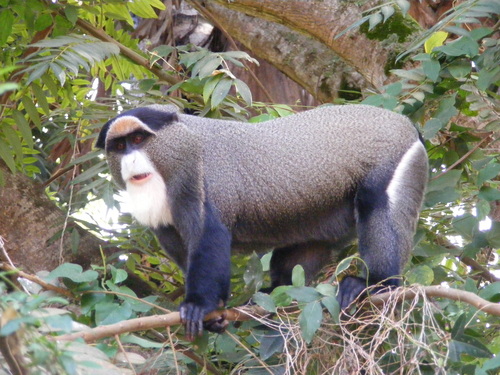
De Brazza's Monkey
The De Brazza's monkey, with its striking white beard and orange crown, is a master of stealth in Africa's dense forests. Its secretive nature and cheek pouches for food storage make it a unique resident of swampy habitats, playing a vital role in seed dispersal.
22-30 years
Lifespan
3.63 - 6.8 kg
Weight
Brown, Grey, Black, White, Orange
Color
5-6 years
Age of Sexual Maturity
Medium
Aggression
Least Concern
Conservation Status
Unknown
Population Trend
Characteristics
Cercopithecus neglectus, commonly known as the De Brazza's monkey, is a primate species native to the dense forests of Central Africa. Recognizable by its distinctive white beard and orange crown, this monkey is known for its secretive nature and adeptness at evading predators. It primarily resides in swampy forests and is a frugivore, feeding on fruits, seeds, and occasionally small animals. Its well-developed cheek pouches are used to store food as it forages.
Distribution Range of the De Brazza's Monkey
Cercopithecus neglectus, commonly known as the De Brazza's monkey, is native to Central Africa. Its geographical distribution includes countries such as Cameroon, Central African Republic, Republic of the Congo, Democratic Republic of the Congo, Equatorial Guinea, Gabon, and parts of Uganda and Kenya.
De Brazza's Monkey's Habitat
Environmental Conditions
The De Brazza's monkey typically inhabits dense, tropical forests, particularly in areas near rivers and swamps. These environments provide the dense canopy and underbrush that the species uses for foraging and protection from predators. The climate is generally equatorial, with high humidity and significant rainfall throughout the year, supporting lush vegetation.
Ecological Niche
Cercopithecus neglectus is arboreal and terrestrial, spending significant time both in trees and on the ground. It is an omnivore, feeding on a diet that includes fruits, seeds, leaves, and small animals. Its role in the ecosystem includes seed dispersal, which contributes to forest regeneration and diversity.
Copyright @ Nature Style Limited. All Rights Reserved.
 English
English